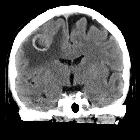Hirnmetastasen Malignes Melanom













Intracranial metastatic melanoma is the third most common brain metastasis.
For a broad discussion about the primary tumor or brain metastasis in general, please refer to the articles:
Epidemiology
A population-based study of 169,444 cancer patients from 1973 to 2001 in Detroit revealed that ~7% of patients diagnosed with melanoma subsequently developed intracranial metastasis .
Clinical presentantion
These patients can commonly present with headaches, seizures, mental status alterations, ataxia, nausea and vomiting, and visual disturbances. However, 10% of patients may be asymptomatic.
Pathology
Melanoma metastases can be artificially divided into "melanotic" (containing greater than 10% melanotic cells on histopathology) or "amelanotic" (containing less than 10% melanotic cells). In 1995, Isiklar et al. published a study in the AJR where only melanotic metastases provided consistent and reliable MR findings (hyperintense on T1 and hypointense on T2). The MR findings of amelanotic metastases were non-specific. Unfortunately, melanotic metastases made up only 25% of the total cerebral melanoma metastases examined .
Radiographic features
Intratumoral hemorrhage is a much more common feature of melanoma metastases in comparison to other brain metastases . Other than choriocarcinoma, metastatic melanomas are the most frequent metastases that are complicated by massive hemorrhage .
CT
Typically, intracranial melanoma metastases consist of a single or multiple nodules with increased attenuation on CT. Out of a series of 101 patients with cerebral melanoma metastases, 62% were found to have multiple lesions (53% localized bilaterally), and 72% of these lesions had increased attenuation . Cystic degeneration and necrosis are rarely seen in these tumors .
- NECT: single to multiple nodules of increased attenuation localized to the gray/white matter junction; variable edema and frequent intratumoral hemorrhage present
- CECT: nodules typically enhance; dural-based, well-enhanced lesions are impossible to differentiate from meningiomas
MRI
The blood products alter the signal on MRI resulting in hyperintensity on T1 and hypointensity on T2 images. However, it should be noted that the melanin pigment has parallel effects on T1 and T2 relaxation times . Thus, the signal changes seen on MRI may be due to either melanin or blood products.
- T1: typically hyperintense secondary to hemorrhage or melanin (as above)
- T2: typically hypointense
- T1 C+: typically enhances in a peripheral rim pattern or a diffusely heterogeneous pattern
- T2*: susceptibility artifacts are commonly encountered secondary to hemorrhage (they are not related to melanin content)
- reported in 42% of cases (compared to 8% of lung metastases)
- some metastases can solely be observable on T2*, although isolated T2* hypointensities should be interpreted cautiously, as other studies reported contradictory findings
Differential diagnosis
On imaging consider:
- other hemorrhagic intracranial metastases
- other melanotic tumors
- other hemorrhages
- hemorrhage into primary brain tumor (e.g. glioblastoma)
- primary lobar hemorrhage
Siehe auch:
- Hirnmetastase
- Aderhautmelanom
- Malignes Melanom Metastase
- Malignes Melanom
- primary cutaneous melanoma
- melanoma of prostate
- eingeblutete zerebrale Metastasen
- primäres malignes Melanom der Urethra
- hyperdense zerebrale Metastasen
und weiter:

 Assoziationen und Differentialdiagnosen zu Hirnmetastasen Malignes Melanom:
Assoziationen und Differentialdiagnosen zu Hirnmetastasen Malignes Melanom:







